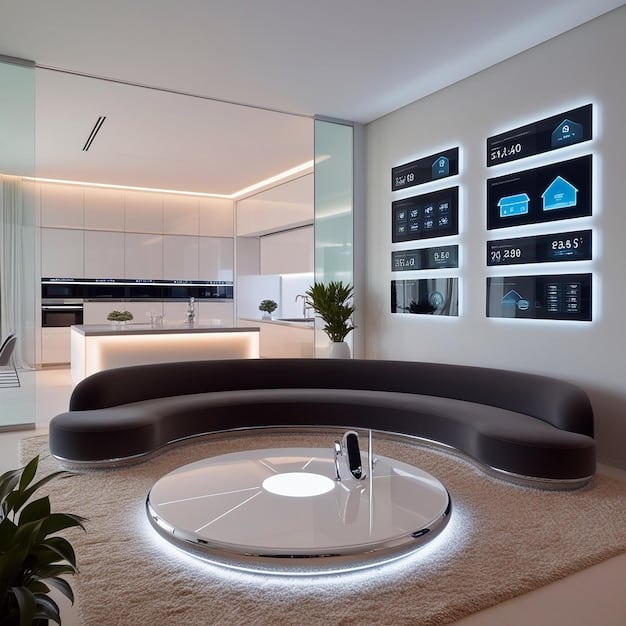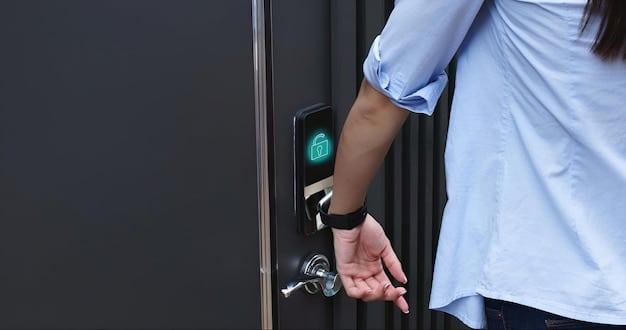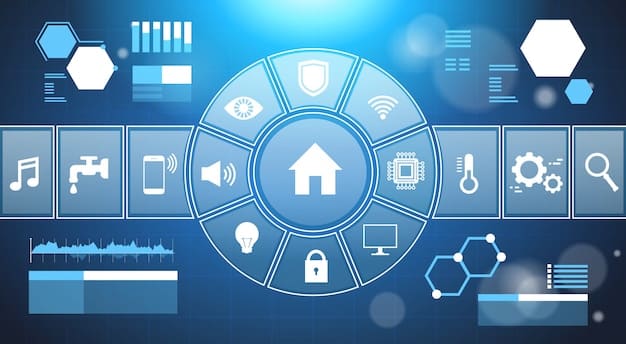The Evolution of Smart Homes in the US: Security, Privacy, and Interoperability

The Evolution of Smart Homes in the US: Security, Privacy, and Interoperability Concerns reflects a journey from simple remote controls to sophisticated, interconnected systems. Today, smart homes offer convenience and efficiency, but raise significant questions about data protection and seamless device integration.
The rise of smart home technology has transformed the way we interact with our living spaces. From automated lighting and temperature control to advanced security systems, smart homes promise convenience, energy efficiency, and enhanced security. However, the evolution of smart homes in the US: security, privacy, and interoperability concerns are becoming increasingly prominent. These issues raise important questions about the safety and control of our personal data and the seamless integration of various smart devices.
As we delve deeper into this technological revolution, let’s explore the key challenges and opportunities that shape the future of smart homes in America. Understanding these aspects is crucial for making informed decisions about adopting and securing smart home technologies.
Understanding the Rise of Smart Homes in the US
The concept of a smart home, once relegated to science fiction, is now a mainstream reality in the United States. Driven by advancements in internet connectivity, sensor technology, and artificial intelligence, smart homes are designed to automate tasks, enhance comfort, and improve security. But what exactly fueled this rapid growth?
Key Factors Driving Adoption
Several factors have contributed to the widespread adoption of smart home technology across the US. These include:
- Increased Affordability: The cost of smart home devices has decreased significantly, making them accessible to a broader range of consumers.
- Enhanced Convenience: Smart devices offer unparalleled convenience, automating tasks such as lighting, temperature control, and security monitoring.
- Improved Energy Efficiency: Smart thermostats and lighting systems can optimize energy consumption, leading to cost savings and environmental benefits.
- Growing Security Concerns: Smart security systems, including cameras and door locks, provide homeowners with increased peace of mind.
As these benefits become more apparent, more and more Americans are embracing the smart home revolution. However, this increased adoption also brings significant challenges, particularly in the areas of security and privacy.

In conclusion, the popularity of smart homes in the US is driven by a combination of affordability, convenience, energy efficiency, and security concerns. While these factors have propelled the market forward, they also raise critical questions about the safety and privacy of smart home technologies, which must be addressed to ensure sustainable growth.
Security Vulnerabilities in Smart Home Devices
While smart homes offer numerous benefits, they also introduce a range of security vulnerabilities that can be exploited by malicious actors. Understanding these vulnerabilities is crucial for homeowners looking to protect their homes and personal data. Let’s examine some of the most common security risks associated with smart home devices.
Common Security Risks
Smart home devices are often vulnerable to various types of cyberattacks, including:
- Hacking: Hackers can gain unauthorized access to smart devices, allowing them to control functions, steal data, or even use devices as entry points into the home network.
- Data Breaches: Many smart devices collect and transmit personal data to the cloud, which can be vulnerable to data breaches. This data may include personal information, usage patterns, and even video and audio recordings.
- Malware Infections: Smart devices can be infected with malware, which can disrupt their normal functions, steal data, or even turn them into bots for distributed denial-of-service (DDoS) attacks.
Examples of Security Breaches
There have been several high-profile security breaches involving smart home devices, highlighting the real-world risks associated with these technologies. In one notable case, hackers gained access to baby monitors and used them to harass families. In another incident, vulnerabilities in smart door locks allowed thieves to remotely unlock doors and gain access to homes. These incidents underscore the importance of taking proactive steps to secure smart home devices.
To summarize, the security vulnerabilities present in smart home devices pose substantial risks to homeowners. From hacking and data breaches to malware infections, these vulnerabilities can compromise both physical security and personal privacy, necessitating robust security measures.
Privacy Concerns and Data Protection
Smart homes collect vast amounts of data about our daily lives, raising significant privacy concerns. From our sleep patterns to our entertainment preferences, smart devices track and analyze our behavior, creating detailed profiles that can be used for various purposes. Protecting this data is essential for maintaining our privacy and autonomy. The evolution of smart homes in the US: security, privacy, and interoperability concerns is closely linked to the need for robust data protection measures.
Data Collection Practices
Smart home devices collect data through various sensors and monitoring systems. This data may include:
- Usage Patterns: Smart devices track how we use them, including when we turn on lights, adjust the thermostat, or use appliances.
- Personal Information: Many smart devices require us to provide personal information, such as our name, address, and contact details.
- Location Data: Some smart devices track our location, allowing them to provide location-based services or monitor our movements within the home.

Data Usage and Sharing
The data collected by smart home devices is often used for purposes beyond simply providing the services we expect. This data may be used for:
- Targeted Advertising: Smart home data can be used to create detailed profiles of our interests and preferences, which can then be used to target us with personalized ads.
- Data Sharing with Third Parties: Some smart home companies share our data with third parties, such as marketing firms and data brokers.
- Profiling and Analysis: Smart home data can be used to create detailed profiles of our behavior, which can then be used for various purposes, such as credit scoring or insurance assessments.
In brief, the extensive data collection practices of smart home devices raise serious privacy concerns. The ways in which this data is used and shared can have significant implications for our privacy and autonomy. As such, it is crucial to understand and address these concerns to ensure that smart homes do not come at the cost of our personal privacy.
Interoperability Challenges and Solutions
One of the biggest challenges facing the smart home industry is the lack of interoperability between different devices and platforms. This means that devices from different manufacturers may not work seamlessly together, creating a fragmented user experience. Addressing this challenge is crucial for realizing the full potential of smart homes. The evolution of smart homes in the US: security, privacy, and interoperability concerns highlights the need for unified standards and solutions.
The Problem of Fragmentation
The smart home market is characterized by a wide range of competing standards and protocols. This fragmentation makes it difficult for consumers to create a truly integrated smart home ecosystem.
Efforts Towards Standardization
Various industry initiatives aim to promote interoperability and standardization in the smart home market. These include:
- Matter: A new connectivity standard designed to enable seamless interoperability between smart home devices from different manufacturers.
- Zigbee and Z-Wave: Established wireless communication protocols that promote interoperability within their respective ecosystems.
Overall, the lack of interoperability is a significant challenge in the smart home market. Efforts towards standardization are essential for creating a more seamless and user-friendly smart home experience, and overcoming this challenge is a key step in the continued evolution of smart homes.
Best Practices for Securing Your Smart Home
Securing a smart home requires a proactive approach, involving both technical measures and behavioral changes. By implementing best practices, homeowners can significantly reduce their risk of security breaches and privacy violations. Here are some essential tips for securing your smart home.
Essential Security Tips
Protecting your smart home involves several key steps:
- Change Default Passwords: Always change the default passwords on your smart devices to strong, unique passwords.
- Enable Two-Factor Authentication: Enable two-factor authentication (2FA) whenever possible to add an extra layer of security to your accounts.
- Update Firmware Regularly: Keep your smart devices updated with the latest firmware to patch security vulnerabilities.
- Secure Your Wi-Fi Network: Use a strong password for your Wi-Fi network and enable encryption (WPA3) to protect your network from unauthorized access.
Privacy-Enhancing Measures
Protecting your privacy in a smart home involves careful consideration of data collection practices and privacy settings:
- Review Privacy Policies: Carefully review the privacy policies of your smart devices to understand what data they collect and how it is used.
- Adjust Privacy Settings: Adjust the privacy settings on your smart devices to limit data collection and sharing.
- Use a VPN: Consider using a virtual private network (VPN) to encrypt your internet traffic and protect your privacy.
In conclusion, securing a smart home requires a multi-faceted approach, combining technical measures with privacy-enhancing practices. By following these best practices, homeowners can significantly reduce their risk of security breaches and protect their personal data, ensuring a safer and more secure smart home environment.
| Key Point | Brief Description |
|---|---|
| 🏠 Smart Home Growth | Driven by affordability, convenience and security. |
| 🛡️ Security Risks | Hacking, data breaches, and malware infections. |
| 🔒 Privacy Concerns | Extensive data collection and sharing practices. |
| 🤝 Interoperability | Fragmentation hinders seamless device integration. |
Frequently Asked Questions
The primary drivers include increased affordability of devices, enhanced convenience, improved energy efficiency, and growing security concerns. These factors contribute to the expanding popularity of smart homes.
Common vulnerabilities include hacking, data breaches, and malware infections. These risks can compromise both physical security and personal privacy within a smart home environment.
These concerns impact consumers by raising questions about data protection, device security, and seamless integration. Addressing these issues is vital for sustainable growth.
Homeowners should review privacy policies, adjust privacy settings on devices, and consider a VPN to encrypt internet traffic and protect collected personal data.
Industry initiatives like Matter, Zigbee, and Z-Wave aim to promote interoperability between devices from different manufacturers, creating a more seamless user experience.
Conclusion
In conclusion, the evolution of smart homes in the US: security, privacy, and interoperability concerns is a complex interplay of technological advancements and emerging challenges. While smart homes offer unparalleled convenience and efficiency, it is crucial for consumers and industry stakeholders to address the associated security and privacy risks proactively.
By understanding these concerns and implementing best practices, we can harness the benefits of smart home technology while safeguarding our personal data and ensuring a secure, connected future. The ongoing efforts toward standardization and increased consumer awareness are essential steps in this journey.





